The AMD Llano Notebook Review: Competing in the Mobile Market
by Jarred Walton & Anand Lal Shimpi on June 14, 2011 12:01 AM ESTApplication Performance, Round One: PCMark 7
If the battery life was a pleasant change of pace, general application unfortunately remains a weak spot for AMD. Remember that Llano uses a tweaked K10.5 architecture for the CPU portion of the core, and while L2 cache per core is doubled relative to the previous generation quad-core Phenom parts, clock speeds and IPC (instructions per clock) still appear much lower than what Intel offers. I had hoped to see Turbo Core come into play here, which makes the comparison with Toshiba’s A660D a good starting point. That notebook has a Phenom II X4 P920 (quad-core 1.6GHz) with HD 5650M graphics, so the Llano A8-3500M has very similar specs.
Before we get to the graphs, let me make a quick note that not all laptops have been tested in all applications/games. Most of the systems have been shipped back to the manufacturer, so our newer benchmarks are going to have omissions (e.g. PCMark 7). In the gaming charts later in the review, we’ll have even more omissions, and many of the slower GPUs/IGPs will only be tested at our “low” settings.
With that out of the way, let’s start our application performance comparison with PCMark7, our only all-inclusive benchmark for laptops right now. We’ve run all of the benchmarks suites in the hopes of providing a better look at overall performance; however, outside of the “Computation” suite all of the tests have a storage element. That means any system with an SSD (like the quad-core SNB unit) will boast a massive advantage over the competition. The Computation suite also has an interesting footnote in that it supports Intel’s Quick Sync for video encoding, which again gives SNB systems a massive performance advantage. You can read more about the specific suites in PCMark 7 in their whitepaper. We’ll also have two results for Llano going forward: one for using the fGPU (6620G) and a second for using the dGPU (6630M).
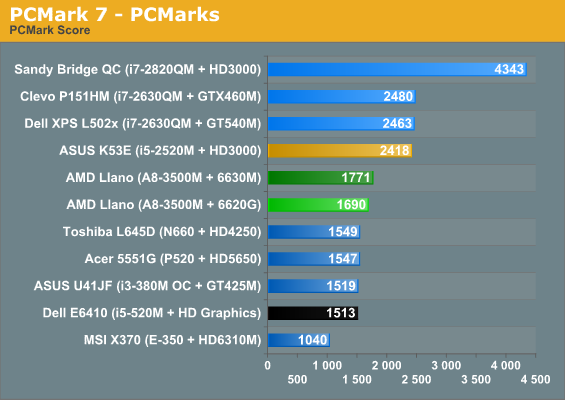
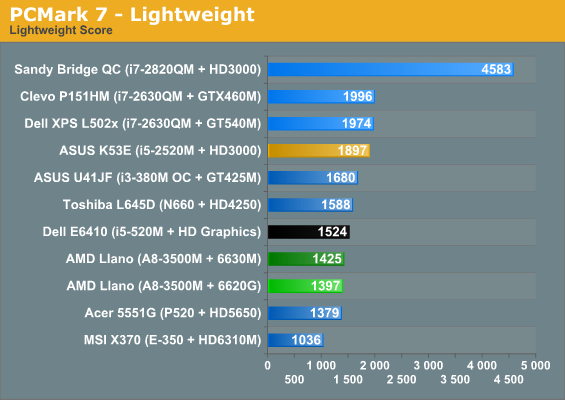
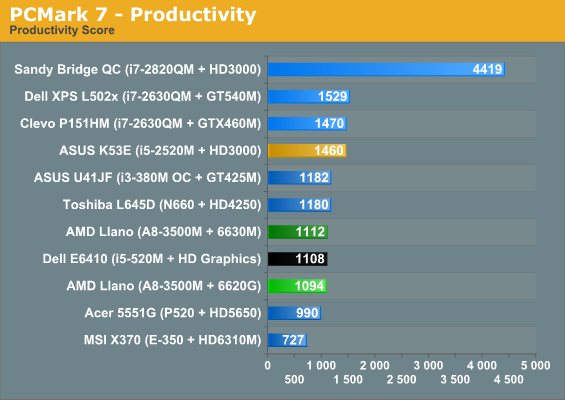
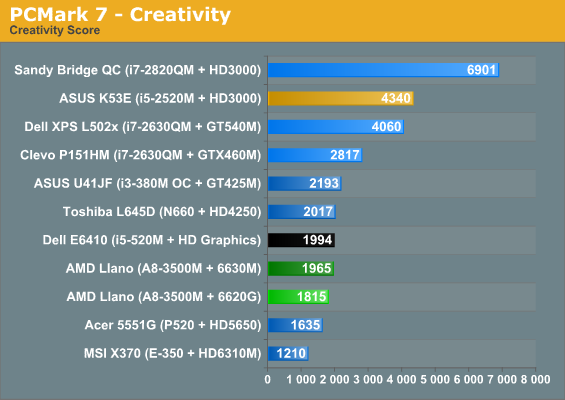
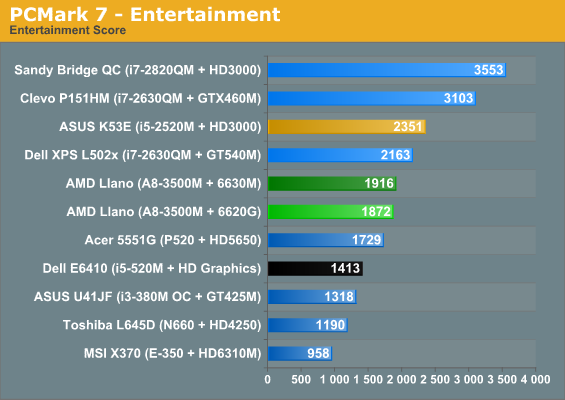

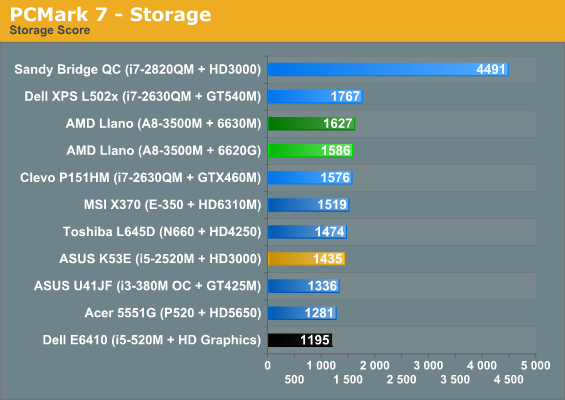
And here’s our first hint that Llano may not be the homerun so many were hoping to see from AMD. All of the SNB laptops are still a healthy step up from Llano in overall PCMarks—the K53E leads by 43%, and systems with quad-core SNB are faster still. Llano might appear to at least surpass the previous generation Arrandale i5-520M in Dell’s E6410, but the storage subsystem in that laptop is a particularly slow 160GB HDD and that skews the results. Then again, the overclocked Arrandale i3-380M in the ASUS U41JF falls short of Llano, so AMD is at the very least competitive with Arrandale.
Since we’re not on a level playing field as far as storage, we won’t comment too much more here, but I do have SSD-based testing complete for four of the notebooks, and once I’ve swapped in an SSD for Llano we’ll have a follow-up article. Let’s move on to application testing round two, where we’ll look at some tests where we eliminate the storage bottleneck.










177 Comments
View All Comments
ET - Tuesday, June 14, 2011 - link
So, what do you tell them? The only benchmarks of The Sims 3 I could find are pretty old and didn't offer much detail, but I think based on them that high quality would require more than the lowest IGP. (Then again, normal or low quality should probably run fine on anything.)msroadkill612 - Tuesday, August 2, 2011 - link
ta 4 the post - but dont salesmen have a duty to sell them a bit of insurance against the next game fadash9 - Tuesday, June 14, 2011 - link
Bring on the OpenCL apps, excuse me applications- Excel rewritten to take advantage of heterogeneous computing would silence everyone about Star CPU cores. The ball is in the hands of the people (to buy them), then the software developers (to program for them) - that's why Star cores? APU apps neededmsroadkill612 - Tuesday, August 2, 2011 - link
I think it will happen. Big mobs will identify niches that can profit from OGPL & profit from using it - open languages always win in the end.I see fusion server apuS in the future.
FISHRULE - Tuesday, June 14, 2011 - link
What a terrible CPU, who would want something that performs like a Phenom in a new computer circa 2011. The future might be fusion AMD, but you sure as heck aren't part of the future anymore.jabber - Tuesday, June 14, 2011 - link
90% of laptop owners wouldnt know if they were using a Brazos or an i5 in their laptops.The only real differential is in transcoding, ripping etc. and very few folks in the real world actually do that. Especially on laptops.
Price is far more important than outright performance. Has been for some time now.
RussianSensation - Tuesday, June 14, 2011 - link
False. My gf doesn't know anything about computers. But she somehow knew that Intel makes the best mobile CPUs even before asking me what to get. Clearly Intel marketing > AMD's. All of my current friends who just bought a computer all went with i3/i5/i7 processors only because they "heard" Sandy Bridge is the fastest CPU around.Llano is nothing more than a Phenom with a faster GPU. Phenom already didn't sell well against C2D/C2Q/Core i7 (1st) gen and isn't getting any better against SB. The only way AMD is gaining market share is if they ship cheap laptops with Llano to users for whom the price of a laptop is the most important factor.
ET - Tuesday, June 14, 2011 - link
Well, you have pretty computer literate friends. Most people I know would have no idea what Sandy Bridge is, probably not even what i3 and i5 are, and would only buy i3 or i5 because: a) AMD had very little market presence until now; b) I'd recommend them. That said, most of the people I know have no idea that AMD exists and is making CPU's (I mention it occasionally, and they're always surprised, so I guess it doesn't register), so it does look like AMD's marketing is pretty crappy.That said, I think that your analysis of why Llano will fail isn't right. For most people the CPU power really doesn't matter that much. They'd have no idea if i3 or Llano is better, and most likely won't be able to tell the difference in practice (unless they run a game for which the HD 3000 is unsuited). Sure Llano is for the low end market, but that's where most sales are, and it's certainly much improved in terms of power usage, which is an important enough measure to help it gain market share.
RussianSensation - Tuesday, June 14, 2011 - link
You are probably right that most people won't tell the difference between a Llano or an i3/i5/i7. But to them the perception of knowing that they have a slower CPU is what matters. One of my friends was building a PC for browsing the net only. I told him he'd be perfectly fine with a $100 CPU but he insisted that the system must have Sandy Bridge because it's the latest modern CPU. I gave up trying to convince him that his internet browsing experience will be more limited by his ISP latency and speed rather than CPU performance.So as long as AMD convinces the average consumer that Llano is at at least as good, they will do well. The problem is AMD's marketing department is worse than a 1st year undergrad student studying marketing in business school. They think if they pay millions of dollars to put AMD on F1 cars, people will notice?
You made a very important point - a lot of people don't even know what AMD is or that there is another competitor to Intel. Imagine if GM, Ford or Chrysler made cars that were more reliable than Honda or Toyota. It would still be a while until the average consumer would abandon the Japanese brands since the perception of reliability would lag behind reality. AMD has this similar problem with their CPU brands, which only marketing can fix.
jrs77 - Tuesday, June 14, 2011 - link
Really... that's rather unimpressive.The GPU of Llano beats intels HD-graphics in games, what a surprise. But how many people do I know personally, that play games on their laptops anyways? Laptops are primarily used as mobile office-computers and they do still rely more on CPU-performance.
From all the experience I've made the HD3000 graphics of mobile SNB CPUs are perfectly fine for all tasks I throw at them (excluding games). So the question is, why would I buy a Llano-based laptop instead of a SandyBridge one?
Llano doesn't offer better battery-life so the only reason might be the price, but with i5-2xxx laptops starting at $600 I really don't see alot of competition there for intel, if we're talking anything else then gaming.